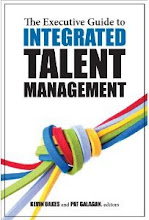I’m late in providing my summary of Tucana’s
People Analytics World 2017 and have struggled to find a topic that others have
not already written about. However I think one useful perspective may be the
level of variety within analytics at the moment.
This applies firstly to analytical approaches.
Most of the presentations, not unnaturally, focused on quantitative
analytical approaches. My favourite from these case examples was Microsoft’s
use of social traffic metadata to suggest best practice behaviours of the most
effective managers. Becky Thielen and Jeremy Tyers explained that this has
shown, for example, that effective managers maintain larger networks than their
reports:
- Employees reporting to managers with large networks are 7% more
engaged and have networks up to 85% larger
- Employees with networks 110% larger than their managers are 50% more
likely to be disengaged.
However, I also enjoyed the qualitative
examples, eg Adidas’s analysis of employee experience during key moments
that matter, following the same approach used for the company’s customers, and
applying across HR / management activities, workplace and the digital
workspace. This involved an an automated employee response system providing a
Net Promoter Score, but also open text comments, and textual analytics to help
see summaries and patterns across the business. Stefan Hierl suggested that to
really need to understand what’s going on for people you need to read this
stuff and hence gave leaders access to the comments of their people. He often
talks to leaders about the numbers but you also need an equal focus on the
qualitative side - what’s in the minds of people as this provides a better
feeling for what’s going on. At Adidas, listening to people is a core
competence of HR - we should not outsource this.
Similarly, some of the presentations focused on
very data oriented approaches. I liked Experian’s example of flight risk
modelling, taking data on over 200 employee attributes from multiple sources and
plugging it into Experian’s business modelling tools. This has delivered circa
20 key statistically significant attributes.
But what I really liked about this particular
conference was its heavy focus on a strategy based approach. This started with Alec
Levenson’s session noting that the tasks and behaviors that do not improve
strategy execution vastly outnumber the ones that do. Therefore analytics needs
to start with strategy not data. The point was at least partly supported by Peter
Howes noting that incremental improvement on traditional data reporting
tends not to work that well.
Even more important than this level of variety
about analytics was the variety about people management itself. This includes
different views about the direction of causality between culture and behaviour,
and engagement and performance. Peter Howes asked us whether we are making
decisions about people with the same intellectual rigour as our decisions about
other business factors: Finance, Sales, Production, Supply Chain. Whilst we
don’t even fully understand the role of something as central as engagement this
struck me and at least some other delegates at the conference as a rather
ludicrous suggestion.
I think the amount of variety I have described
above has a couple of important consequences.
1. There
cannot be a single maturity curve which all organisations need to follow. I
much prefer Deloitte’s and 3n Strategy’s approach of identifying different
aspects of analytical maturity each of which can be strong or weak independently
of each other (eg Deloitte’s categories of strategy, people, process,
technology and data).
However, for many organisations, the best
approach may be a combination of the various approaches. For example, Eden
Britt at HSBC presented a heavily quantitative, data oriented approach, involving, for example, several
smart analytical approaches for providing insight on attrition:
- Clustering - which are the areas of high attrition?
- Machine learning - who will leave?
- Text mining - where will they leave to?
- Markov models - when will they leave?
But Britt also emphasised the importance of
deciding upon:
- What is the question you are trying to answer?
- What is your hypothesis?
- What data do you have?
His suggestion when requested to provide yet
more data is to always ask: “How’s that data going to help you make a better
decision or to do something in a different way?”
2. I think the variety in our approaches also
raise broader challenges to emerging or prevailing wisdom:
- It means there is limited use for standardised taxonomies. These may
be OK for whether someone has a driving licence but not for eg employee
engagement, or for analytics itself. These may help keep the lights on cheaper
but they also interfere in the search for competitive advantage.
- It may also mean there is limited use for benchmarking models and
tools. For example, when comparing cultures, is hierarchical opposite to
delegating?, or professional the opposite to social? - they’re not in my view
of the world.
- It means that setting up a professional body for people analytics
would be largely unhelpful. At this point in the evolution of the people
analytics field we need to encourage conversation on different perspectives
rather than to see these constrained.
Thanks to Tucana and all the speakers for
sharing their various approaches.
- Consulting Research Speaking Training Writing
- Strategy - Talent - Engagement - Change and OD
- Contact me to create more value for your business
- jon [dot] ingham [at] strategic [dash] hcm [dot] com






























